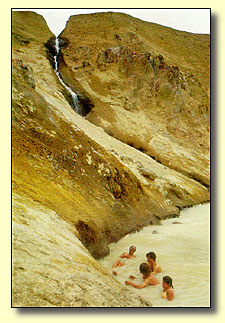
Bubbling
mud flats, lunaresque volcanic craters,
newborn lava fields, and grassy shoals
teeming with waterfowl; these are among
the sights of the striking Lake Myvatn
region, one of the most geologically
active and stunningly beautiful areas in
Iceland. In 1974, the lake was declared a
national conservation area, and since
then it has become one of the most
popular tourist destinations in the
country. It’s name means “Midge
Lake,” after the hordes of gnats
that breed in the shallow waters (so
bring bug spray), but the pesky insects
– perfect food for fish – support the best
trout and salmon fishing in Iceland. There are also
more species
of duck here than anywhere in Europe, 15
in all.
The heavy volcanic
activity in the region during the last
few thousand years accounts for its
extraordinary land formations and
geology. Dimmuborgir, on the East
side of the lake, is a badlands of lava
pillars, some of which reach 65 feet in
height. Just north is Hverfjall, a
smooth, stadium-shaped volcanic cone that
formed during eruptions 2500 years ago.
One of the most bizarre attractions in
the region are the mud pits of Haverarond,
which are so hot that they actually boil.
Far cooler are the waters of Viti,
an explosion crater where you can bathe
in a comfortable 22C hot spring. Another
unforgettable sight near Myvatn is Eldhraun (“fire lava”),
an absolutely barren lava field where the Apollo 11
crew came in the late 60s to train for
their impending moonwalks.
Reykjavik | Blue Lagoon | Geysir | Gullfoss | Akuryeri |
Thingvellir
| Snaefellsnes
Peninsula | Lake
Myvatn | Westmann
Isles
|
|